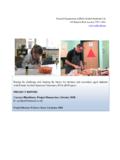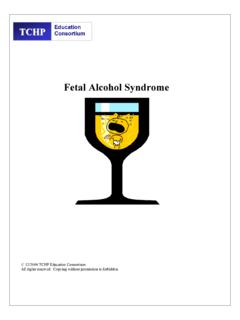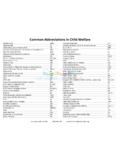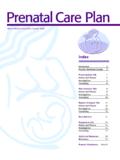Transcription of Antonín Šípek - Vrozené vady
1 Teratogens and Congenital Anomalies Institue of Biology and Medical Genetics National Registry of Congenital Anomalies anton n pek Congenital Anomaly Definitions Congenital Anomaly / Birth Defect - Morphological an/or functional anomaly - Result of an abnormal prenatal development - Presented at birth - At least slightly pathological Congenital vs Aquired Examples Birth defects surveillance: Atlas of selected congenital anomalies. WHO, 2014 Teratogenesis Teratogenesis is process leading to the formation of a congenital anomaly. Factors involved in teratogenesis are called teratogens. The appropriate branch of medicine is called teratology. Ethiology 55 22,5 6,5 7,5 8,5 Etiology unknownMultifactorial heredityChromosomalaberrationsGene mutationsEnvironmental factorsMoore K.
2 L., Persaud T. V. N.; The Developing Human: Clinically Oriented Embryology, 6th Edition; 1998 Teratogenesis Long and complex process. The role of teratogens depends on: species gestation age dose of teratogen genotype of the embryo (and mother) Experimental teratology Basic principles of teratology Rattus norvegicus, Drosophila melanogaster Testing of embryotoxicity using models CHEST (Chick Embryotocicity Screening Test) Teratogens Physical, chemical or biological Not all teratogens are mutagens! They can affect the embryo in many other ways: Cell cycle inhibition Cytotoxical effects Receptor and or regulation interference Inhibition of the enzymes Teratogenesis in man Please note First two weeks of gravidity are completely safe from the teratological point of view.
3 Exposition during the first trimester has the most severe consequences. Teratogen exposition in gravidity is an indication for genetic counseling. Physical teratogens X-rays (common diagnostic doses are not dangerous) Ionizing radiation ( gamma radiation) High temperature (sauna, fever) Mechanical factors (amniotic bands, oligohydramnion) Ultrasonography and electromagnetic field seem to be safe. Chemical teratogens chemical substances used in industry or agriculture (organic solvents, paints, polychlorinated biphenyls, heavy metals) alcohol (cause Fetal alcohol syndrome) products of cigarette smoking (teratogenic effect of marihuana smoking was also proved) other drugs ( cocaine), doping (steroids) cytostatics and some other groups of medicaments (antiepileptics, antibiotics, warfarine, ACE-inhibitors) Drugs The four main groups of drugs according to teratogenic effect: effect proved (cytostatics, methotrexat and aminopterin, warfarine, high doses of vitamin A, alcohol, cocaine).
4 Effect presumable (antiepileptics, lithium). effect possible (hormones, amphetamin, diazepam, enzyme inhibitors, d-penicilamin). effect cannot be excluded. Prooven teratogens Alcohol (facial dysmorphy, brain growth retardation, congenital anomalies of the heart) Warfarine (chondrodysplasia punctata, risk of abortion) Retinoids (anomalies like Di-George syndrome, anomalies of CNS, anomalies of the internal ear) Aminopterine + Methotrexate (anomalies of cranium and skeleton, anencephaly) Thalidomide (abnormal development of long bones, phocomelia, polydactyly, syndactyly, oligodactyly and other malformations) Fetal alcohol syndrome Warfarine syndrome Biological teratogens Infectious agents TORCH (acronym for most important teratologic agents)
5 Toxoplasma Other Rubivirus Cytomegalovirus Herpesvirus Diseases of the mother Diabetes mellitus (DM) Phenylketonuria (PKU) Inections Rubivirus (cataract, deafness, anomalies of the heart, microcephaly, mental retardation) Cytomegalovirus (microcephaly, chorioretinitis, deafness, hepatosplenomegaly) Varicella-Zoster virus (microcephaly, chorioretinitis, defects of the extremities, mental retardation, cataract) Parvovirus B-19 (hydrops fetalis, anemy, malformation of the heart) Influenzavirus (failure of the CNS closure) Coxsackie virus (fetal pancreatitis and fetal meningoencephalitis) HIV (immunodeficiency, dysmorphy) Treponema pallidum (failure of teeth development, IUGR, hydrops fetalis) Toxoplasma gondii (hydrocephaly, microcephaly, chorioretinitis, blindness) Please note St tn stav pro kontrolu l iv (S KL) European Medicines Agency (EMEA) U S Food and Drug Administration (FDA) esk teratologick informa n slu ba (CZTIS) European Network Teratology Information Services (ENTIS) Organization of Teratology Information Specialists (OTIS) Classification Malformation is caused by an abnormal development of the organ / tissue, that is abnormal from the beginning.
6 Disruption is caused by destructive process, that affects an organ / tissue, that started to develop normally. Deformation is caused by an abnormal physical force, that damages healthy organ / tissue. Dysplasia is caused by an abnormal organization of the cells in the organ / tissue. Classification Isolated anomaly: an anomaly that is not associated with any other conditions ( isolated polydactyly). Sequence: multiple anomalies that result from the pathologic cascade caused by a primary insult ( Potter s sequence). Association: selected congenital anomalies that tend to develop all together in an association ( VATER association). Syndrome: complex of phenotypic traits (anomalies) that are typical for defined clinical diagnosis ( Down syndrome).
7 Examples Potter sequence Shastry et al., JClinNeonat, 2012 Amniotic bands Rujiwetpongstorn a Tongsong, Jperinatol, 2008 History Historick reprodukce osob s vrozen mi v vojov mi vadami (st edov k) Holl nder E. (1921) Wunder, Wundergeburt und Wundergestalt in Einblattdrucken des f nfzehnten bis achtzehnten Jahrhunderts, Stuttgart, 373 s. Measles N. MCALISTER GREGG (1942) Congenital cataract following german measles in the mother. Trans Ophthalmol Soc Austr 3, 35 46. Thalidomide On market 1957 -1962 Thalidomide 6000-8000 affected children worldwide Thalidomide Frances Oldham Kelsey Thalidomid Possible mechanisms: Interference with IGF-1 (Insulin-like growth factor 1) gene promotor Inhibition of FGF2 protein (Fibroblast growth factor 2) oxidative stress possible inhibition of Cereblon protein which is involved in FGF8 (Fibroblast growth factor 8) gene expression Radiation Only one type of congenital anomaly (microcephaly) was found in elevated numbers in Japan after nuke attack on Hiroshima and Nagasaki.
8 (Plummer, 1952; Yamazaki et al., 1954; Sutow a West, 1955) 1945 Radiation No changes in incidences of congenital anomalies were found after the incident at Three Mile Island. (Upton, 1981; Kalter, 2003) 1979 Radiation Higher incidence of thyroid cancer was reported in the Chernobyl area. However no association with congenital anomalies numbers increase was proved. (Kotz, 1995; Castronovo, 1999; Hoffmann 2001; Kalter, 2003) 1986 Radiation No increase of incidences of congenital anomalies was found in Japan after Fukushima disaster (Hirahara, 2011 and 2012) 2011 Examples Neural tube defects (NTD) Anencephaly Encafalocele Spina bifida Abdominal wall defects (AWD) Omphalocele Gastroschisis Anencephaly WHO/CDC/ICBDSR.
9 Birth defects surveillance: atlas of selected congenital anomalies. Geneva: World Health Organization; 2014. Craniorhachischisis WHO/CDC/ICBDSR. Birth defects surveillance: atlas of selected congenital anomalies. Geneva: World Health Organization; 2014. Spina bifida WHO/CDC/ICBDSR. Birth defects surveillance: atlas of selected congenital anomalies. Geneva: World Health Organization; 2014. Spina bifida WHO/CDC/ICBDSR. Birth defects surveillance: atlas of selected congenital anomalies. Geneva: World Health Organization; 2014. Spina bifida WHO/CDC/ICBDSR. Birth defects surveillance: atlas of selected congenital anomalies. Geneva: World Health Organization; 2014. Encephalocele WHO/CDC/ICBDSR. Birth defects surveillance: atlas of selected congenital anomalies.
10 Geneva: World Health Organization; 2014. Encephalocele WHO/CDC/ICBDSR. Birth defects surveillance: atlas of selected congenital anomalies. Geneva: World Health Organization; 2014. Omphalocele WHO/CDC/ICBDSR. Birth defects surveillance: atlas of selected congenital anomalies. Geneva: World Health Organization; 2014. Gastroschisis WHO/CDC/ICBDSR. Birth defects surveillance: atlas of selected congenital anomalies. Geneva: World Health Organization; 2014. Diagnostics Prenatal Postnatal Prenatal diagnostics Biochemical screening (not primary method for CA diagnostic) 1st trimester (PAPP-A, Beta-hCG) + USG markers 2nd trimester (AFP, hCG, uE3) Offered to all pregnant women Ultrasound diagnostics (all pregnant women) Fetal echocardiography (selective) MRI diagnostics (highly selective) Invasive diagnostics (selective) AMC, CVS, CC Cytogenetic or targeted molecular genetic not primary method for CA diagnostic Postnatal examination Examination of the newborn Delivery unit Palate Eyes, ears Heart (auscultation)








